Class 10 Life Processes Notes
Notes Previous Years Questions Important QuestionsLife Processes Notes
Life Processes:-
The processes which together perform the maintenance job of the living organisms are called life processes.
Nutrition:-
The process of taking of food inside the body and utilising it to get energy is known as nutrition.
Modes of nutrition:-
- Autotrophic mode of nutrition
- Heterotrophic mode of nutrition
Autotrophic mode of nutrition:-
The mode of nutrition in which the organisms prepare their own food is called autotrophic mode of nutrition.
Examples of autotrophs are:- plants and cyanobacteria (blue green algae).
Photosynthesis:-
The process by which green plants prepare their own food using carbon dioxide and water in the presence of sunlight and chlorophyll is known as photosynthesis.
![]()
The processes involved during photosynthesis are:-
- Absorption of light energy by chlorophyll
- Conversion of light energy to chemical energy and splitting of water molecules into hydrogen and oxygen
- Reduction of carbon dioxide to carbohydrates
Stomata:-
The tiny pores present on the the surface of the leaves are called stomata.
Functions of stomata:-
- Exchange of gases
- Transpiration:- The loss of excess water in the form of water vapour by plants is called transpiration.
➢ Nitrogen is converted into inorganic nitrites or nitrates by the action of lightening & bacteria like Rhizobium.
➢ The opening & closing of stomata is controlled by guard cells.
Heterotrophic nutrition:-
The mode of nutrition in which the organisms are dependent on other organisms to obtain their food is called heterotrophic nutrition.
Types of heterotrophic nutrition:-
- Saprophytic nutrition:- The mode of nutrition in which the organisms obtain their food from dead and decaying organic materials is called saprophytic nutrition. Ex:- fungi like bread moulds, yeast, mushrooms etc.
- Parasitic nutrition:- The mode of nutrition in which the organism derives its nutrition from other organism without killing it is known as parasitic nutrition. Ex:- Mosquito, amarbel (cuscuta), ticks, orchids, lice, leeches and tape-worms.
- Holozoic nutrition:- The mode of nutrition in which an organism takes the complex food into the body & digests it is called holozoic nutrition. Ex:- Human beings, amoeba, paramoecium, etc.
Nutrition in amoeba:-

Nutrition in human beings:-
Alimentary Canal:- Mouth → Oesophagus ( food pipe) → Stomach → Small Intestine → Large intestine

| Organ | Gland | Juice/Enzyme | Function |
| Mouth | Salivary Gland | Saliva →Salivary Amylase | a. Converts starch into sugar b. Saliva gets mixed with food & makes it wet so that it can easily pass through oesophagous. |
| Stomach | Gastric Gland | Gastric Juices i. Hydrochloric acid ii. Pepsin (enzyme) iii. Mucus | i. a. Kills harmful bacteria that enters with the food b. Makes the medium acidic for the action of enzyme pepsin ii. Digests protein iii. Protects the inner lining of stomach from HCl |
| Small Intestine | i. Liver (largest gland) | Bile Juice | a. Makes the medium alkaline for the action of pancreatic enzymes b. Bile salts break the large fat globules to smaller globules (emulsification of fat) |
| ii. Pancreas | Pancreatic Juice i. Trypsin ii. Lipase | i. Digests proteins ii. Breaks down emulsified fats | |
| iii.Intestinal Glands | Intestinal Juice | a. Converts proteins to amino acids, complex carbohydrates into glucose and fats into fatty acids and glycerol. |
Villi:- The finger like projection present on the inner lining of the small intestine which increases the surface area for the absorption of digested food is called villi.
- The exit of food from stomach & anus is regulated by sphincter muscle.
- Herbivorous animals have longer intestine for the digestion of cellulose.
- Small intestine is known as the site of complete digestion.
Respiration:-
The process of acquiring oxygen from outside the body & to use it for the break down of food sources to get energy is called respiration.
Types of respiration:-
- Aerobic respiration:- The type of respiration which takes place in the presence of oxygen is called aerobic respiration. Or,
The process of breaking down of food molecules to get energy in the presence of oxygen is called aerobic respiration. - Anaerobic respiration:- The process of breaking down of food molecules to get energy in the absence of oxygen is called anaerobic respiration.
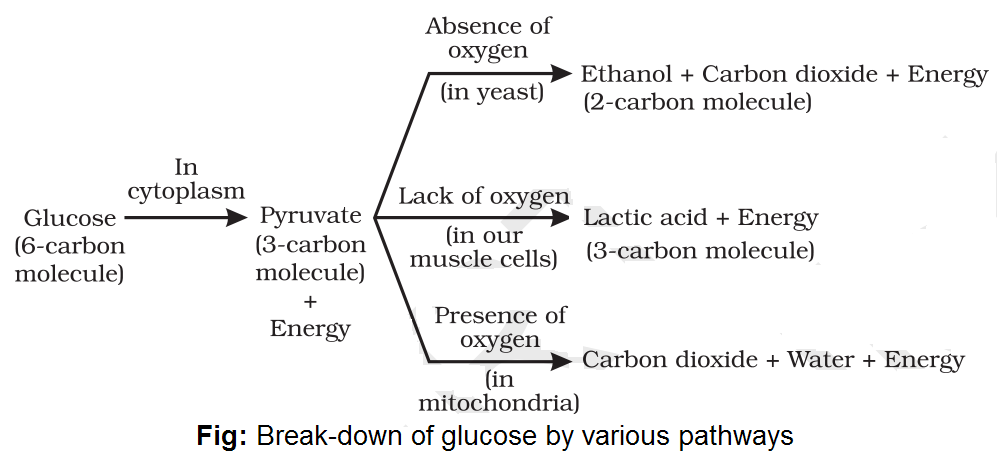
- Energy released during aerobic respiration is much more than anaerobic respiration.
- Sometimes, when there is a lack of oxygen in our muscle cells, pyruvate is converted into lactic acid. This build-up of lactic acid in our muscles during sudden activity causes muscle cramps.
- The energy released during cellular respiration is immediately converted to ATP (Adenosine Triphosphate).
- The nostrils have fine hair and mucus which help to filter the air.
- Rings of cartilage present in the throat prevents the air passage from collapsing.
- Fishes take in oxygen dissolved in water through gills.
- Since availability of oxygen is less in water so,the breathing rate of fishes is much higher than terrestrial organisms.
- Alveoli:- The balloon like structure present in the lungs which provide surface for the exchange of gases are called alveoli.
- Oxygen is transported from the lungs to the body with the help of respiratory pigment, haemoglobin.
- Carbon dioxide is more soluble in water and hence it is mostly transported in the dissolved form in the blood.
In plants, gaseous exchange occur through:-
- stomata in leaves
- lenticels in stems
- surface of the root
Transportation:-
Transportation in human beings:-
- The circulatory system in human beings consists of heart, blood vessels, blood and lymph.
Blood:-
- Blood consists of a fluid medium called plasma in which cells like red blood cells(RBCs), white blood cells (WBCs) and platelets are suspended.
- Plasma transports food, carbon dioxide and nitrogenous waste in dissolved form.
- Oxygen is transported by RBCs.
- WBCs produce antibodies which help to fight against germs and protect us from diseases.
- Platelets help in blood clotting.
Heart:-
- Humans have four chambered heart (while amphibians and reptiles have three chambered heart and fishes have two chambered heart).
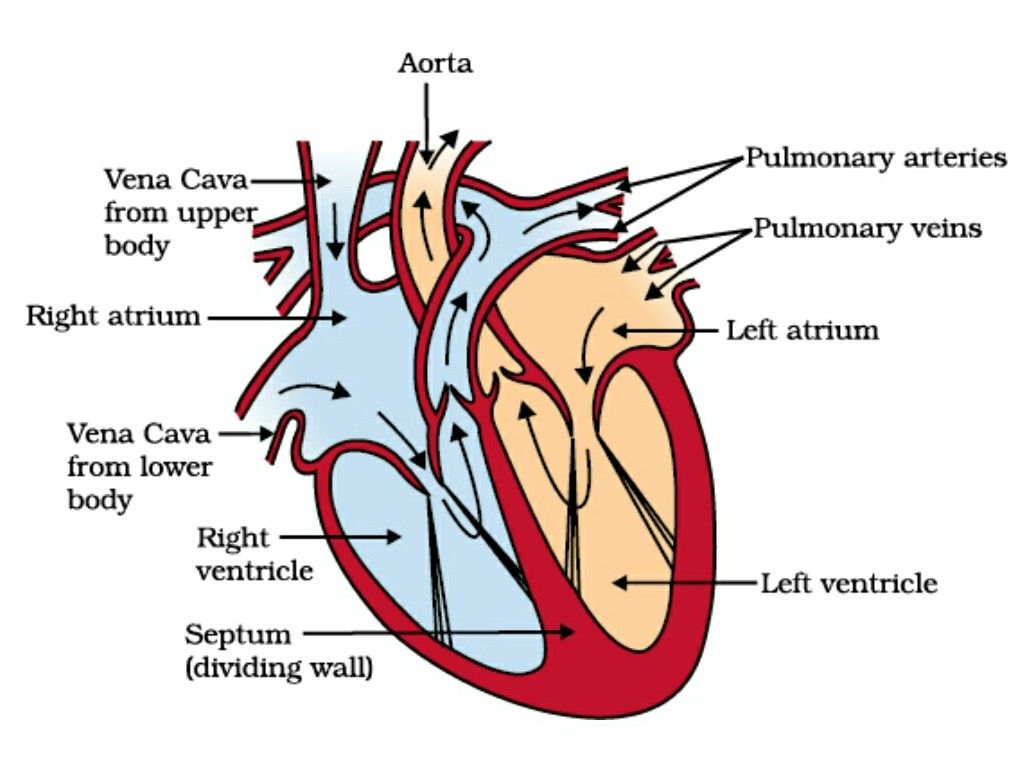
Double Circulation:- In humans, blood enters the heart twice in a complete circulation. So, blood circulation in humans is called double circulation.
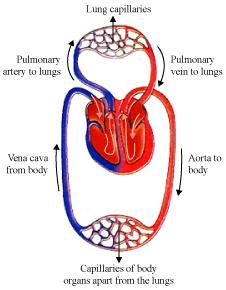
- In fishes , blood goes only once through the heart in one cycle.
Types of blood vessels:-
- Arteries
- Veins
- Blood Capillaries
Difference between arteries and veins:-
| S. No. | Arteries | Veins |
| i. | Arteries carry oxygenated blood. | Veins carry deoxygenated blood. |
| ii. | Arteries carry blood from heart to other body parts. | Veins carry blood from other body parts to heart. |
| iii. | Blood flows in arteries with high pressure. | Blood flows in veins with low pressure. |
| iv. | The walls are thick and elastic. | The walls are thin and less elastic. |
| v. | Valves are absent. | Valves are present. |
- Pulmonary artery carries deoxygenated blood from heart to lungs and pulmonary vein carries oxygenated blood from lungs to heart.
Lymph:-
- It is also called tissue fluid.
- It contains plasma, proteins and blood cells.
- It is colourless.
- It carries digested and absorbed fat from intestine.
- It transports excess fluid from extra cellular space back into the blood.
Transportation in plants:-
| S.No. | Xylem | Phloem |
| 1. | Xylem transports water and minerals in plants. | Phloem transports food, amino acids and other substances in plants. |
| 2. | Movement is in upward direction. | Movement is multi-directional. |
| 3. | Transport occurs due to transpiration and root pressure. | Transport occurs with the help of energy. |
Translocation:- The transport of food and other substances with the help of phloem in plants is called translocation.
Advantages of transpiration:-
- It helps in the absorption and upward movement of water and minerals dissolved in it from roots to the leaves.
- It helps in the regulation of temperature.
- It maintains a constant supply of ions to the leaves.
- It removes excess water from the plant.
Excretion:-
The removal of harmful metabolic wastes from the body is called excretion.
Excretion in human beings:-
- The excretory system of human beings includes a pair of kidneys, a pair of ureters, a urinary bladder and a urethra.
- Kidneys help in removal of nitrogenous waste such as urea and uric acid.
- Urinary bladder is a muscular structure and it is under nervous control.
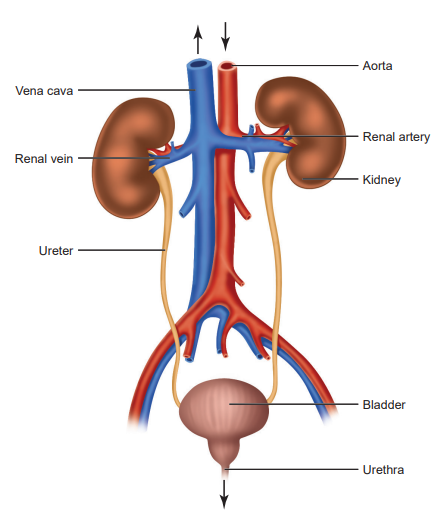
Nephron:- The basic filtration unit of kidney is called nephron.
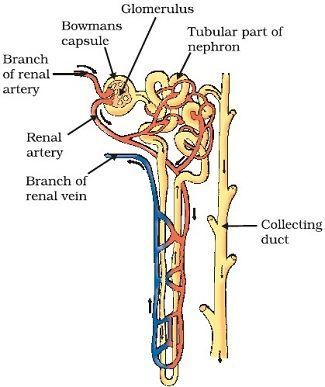
Dialysis:- The process of removing of nitrogenous wastes through artificial kidney is called dialysis.
Excretion in plants:-
- Plants remove excess water by transpiration.
- Plants also produce some excretory wastes in the form of gums, resins etc.
- Some waste products may be stored in leaves that fall off.
- Plants also excrete some waste substances into the soil around them.


Comments